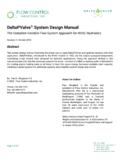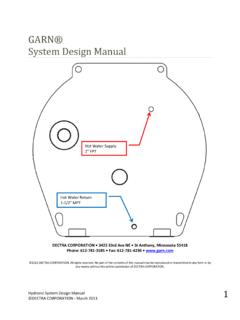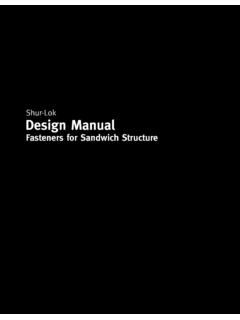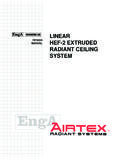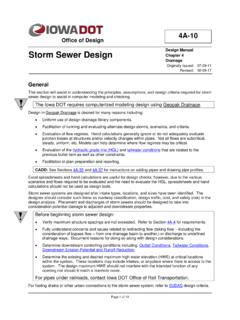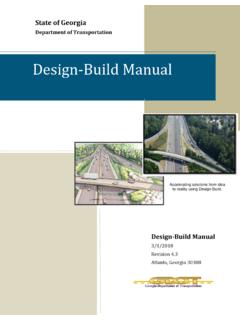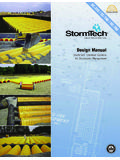Transcription of Traffic Signal Design Manual - Transportation - …
1 Pima County Department of Transportation Traffic Signal Design Manual Second Edition January 2008. Traffic Signal Design . Manual . Pima County Department of Transportation SECOND EDITION. January 2008. TABLE OF CONTENTS. Page Introduction Purpose i Application of Manual i Revision Process i 1. General Information A. Abbreviations 1-1. B. Definitions 1-1. C. CADD Symbols 1-3. D. Standard References for Traffic Signals 1-6. E. Standards for Street Lighting at Signalized Intersections 1-7. F. Sheet Assignment 1-7. G. CADD Level Structures 1-12. H. Other Related Studies 1-12. 2. Pole Placement Standards and Guidelines A. Curb Access Ramp Locations 2-1. B. Curb Access Ramp Landings 2-1. C. Relationship of Curb Access Ramps with Crosswalks and Stop Lines 2-1.
2 D. General Considerations for Traffic Signal Pole Locations 2-2. 3. Traffic Signal Faces and Mounting Hardware A. Traffic Signal Indications 3-1. B. Traffic Signal Faces 3-1. C. Placement Considerations For Traffic Signal Faces 3-1. D. Traffic Signal Mounting Hardware 3-3. 4. Pedestrian Control Features A. Conventional Pedestrian Signals 4-1. B. Accessible Pedestrian Signals 4-1. C. Pedestrian Signal Indications and Push Buttons 4-1. D. Placement Considerations For Pedestrian Signal Heads and Detectors 4-1. E. Other Pedestrian Control Features 4-2. 5. Lighting Requirements For Traffic Signal Installations A. Considerations for Intersection Lighting 5-1. B. Lighting Requirements for Traffic Signal Installations 5-1. 6. Controller Cabinet and Electric Service Pedestal A.
3 Equipment Requirements 6-1. B. Placement Requirements 6-1. 7. Vehicle Detection Standards and Guidelines A. Detection Types and Considerations 7-1. B. Detection Guidelines 7-1. C. Video Detection System Requirements 7-2. D. Vehicle Loop Detection Guidelines 7-2. TABLE OF CONTENTS. Continued Page 8. Conductor Cable Requirements A. General 8-1. B. Signal Power Requirements 8-1. C. Signal Conductor Requirements 8-1. D. Street Light Conductor Requirements 8-2. E. Loop Detector Conductor Requirements 8-2. F. Wireless Communications Requirements 8-2. G. Emergency Vehicle Pre-emption Conductor Requirements 8-3. H. Video Detection Requirements 8-3. 9. Conduit and Pull Box Requirements A. General Requirements 9-1. B. Conduit Size and Placement 9-1.
4 C. Pull Box Considerations 9-1. D. ITS Improvements 9-3. 10. Other Traffic Signal Related Equipment A. Emergency Vehicle Pre-emption Systems 10-1. B. Street Name Signs 10-1. 11. Other Traffic Signals A. Intersection Control Beacons 11-1. B. Warning Beacons 11-1. C. Pedestrian Activated Signals 11-2. Appendix A Sample Signalized Intersection Design Plans Appendix B General Traffic Signal Notes and Responsibilities LIST OF FIGURES. Page Figure 1-1A CADD Symbols 1-4. Figure 1-1B CADD Symbols 1-5. Figure 1-2 NEMA Standard Movements 1-10. Figure 2-1 Pole Placement Standards & Guidelines 2-3. Figure 2-2 3L Undivided X 3L Undivided 2-5. Figure 2-3 3L Undivided X 4L Divided 2-6. Figure 2-4 4L Divided X 4L Divided 2-7. Figure 2-5 5L Undivided X 5L Undivided 2-8.
5 Figure 2-6 4L Divided X 4L Divided, Dual Left 2-9. Figure 2-7 4L Divided X 4L Divided, Right Turn Lane 2-10. Figure 2-8 6L Divided X 6L Divided 2-11. Figure 2-9 6L Divided X 6L Divided, Dual Left 2-12. Figure 2-10 3L Undivided X 3L Undivided, T-Intersection 2-13. Figure 2-11 5L Undivided X 4L Undivided, T-Intersection 2-14. Figure 2-12 4L Divided X 4L Divided, Dual Left, T-Intersection 2-15. Figure 5-1 Street Lighting Circuit Diagram 5-2. Figure 9-1 Conduit Size Guidelines 9-2. Figure 11-1 Modified F Signal Head 11-2. Figure 11-2 HAWK Pole Placement Standards & Guidelines, 3L 11-3. Undivided X 3L Undivided Figure 11-3 HAWK Pole Placement Standards & Guidelines, 3L 11-4. Undivided X 3L Undivided, T Intersection Figure 11-4 HAWK Pole Placement Standards & Guidelines, 3L 11-5.
6 Undivided w/TWLTL. LIST OF TABLES. Page Table 1-1 Pole Schedule Column Designations 1-11. Table 3-1 Mounting Assemblies for Type F, Q and R Signal Faces on 3-3. Mast Arms and Poles Table 7-1 Placement of Pulse Loops 7-3. 1. GENERAL INFORMATION. This section provides general information regarding Traffic Signal designs, sheet assignments, and sheet numbering protocols. A. Abbreviations AASHTO American Association of State Highway and Transportation Officials ADA Americans with Disabilities Act ANSI American National Standards Institute AWG American Wire Gauge IESNA Illuminating Engineering Society of North America IMSA International Municipal Signal Association LED Light emitting diode MUTCD Manual on Uniform Traffic Control Devices NEC National Electrical Code NEMA National Electrical Manufacturers Association PCDOT/TED Pima County Department of Transportation Traffic Engineering Division POLT Protected- Only Left Turn PORT Protected- Only Right Turn PPG Process/Procedure Guideline UPS Uninterrupted Power Supply (Battery Backup).
7 B. Definitions Accessible Pedestrian Signal A device that communicates information about pedestrian timing in non-visual format, such as audible tones, verbal messages, and/or vibrating surfaces. Advance Loop A loop used in advance of an intersection that detects a vehicle's passage, and which is typically used to extend the green interval. Approach All lanes of Traffic moving toward an intersection or a mid block location from one direction, including any adjacent parking lane(s). Backplate A thin strip of material that extends outward from and parallel to a Signal face on all sides of a Signal housing to provide a background for improved visibility of the Signal indications Beacon A highway Traffic Signal with one or more Signal sections that operates in flashing mode Clear Zone The unobstructed, relatively flat area provided beyond the edge of the traveled way for the recovery of errant vehicles.
8 The clear zone includes any shoulder or auxiliary lanes. Call Loop A loop that detects a vehicle and indicates its presence. ISSUED: PCDOT Traffic Signal FIGURE: 01/2002 Design Manual . REVISED: PAGE: 11/2007 General Information 1-1. B. Definitions (continued). Conduit Run An underground conduit from pull box to pull box or from pull box to pole foundation. Multiple conduits in the same trench are given one conduit run number. Conventional Pedestrian Signal A device that communicates information about pedestrian timing in a visual format. Curb Access Ramp A short section of the pedestrian access route that joins the street elevation to the public sidewalk elevation, through a cut in the curb face. Curb Access Ramp Landing A level area on a public sidewalk, adjoining a curb access ramp, used for maneuvering and waiting.
9 Emergency Vehicle Transfer of normal operation of a Traffic Signal to a special Pre-emption mode of operation that quickly gives the green phase for the direction of Traffic from which the approaching emergency vehicle is arriving. HAWK crossing A signalized pedestrian crossing that utilizes flashing and steady red and yellow Signal indications. HAWK is an acronym for High intensity Activated crossWalK. Intersection Control Beacon A beacon used only at an intersection to control two or more directions of travel Lead-in Cable Cable used from the controller cabinet to the embedded loop detectors. Louver A device that can be mounted inside a Signal visor to restrict visibility of a Signal indication from the side, or to limit the visibility of the Signal indication to a certain lane or lanes.
10 Major Street The street normally carrying the higher volume of vehicular Traffic at an intersection. Minor Street The street normally carrying the lower volume of vehicular Traffic at an intersection. Multiconductor Cable A combination of conductors insulated from one another. The component conductors of the multiconductor cable may be either solid or stranded and have a common insulation covering. Multiconductor Cable Schematic An illustration of multiconductor cabling requirements for a Traffic Signal Design that replaces/supplements the conductor schedule. NEMA Traffic Signal Phasing A diagram illustrating Traffic movements at a signalized Diagram intersection that utilizes NEMA standard movement designations. Pedestrian Indication A Signal head, which contains the symbols WALKING.
